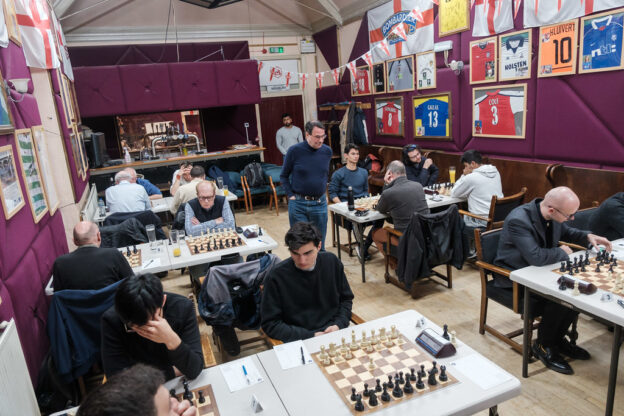Kingston v Wimbledon, Alexander Cup final, played at the Willoughby Arms, Kingston, on 2 May 2024
As far as Kingston are concerned, Alexander cups are like buses. Until 2022, in our post-pandemic golden period, we hadn’t won one since 1976. Now, with this 7-3 victory over a strong Wimbledon team, we have chalked up three in a row.
This is the first hat-trick of Alexander cups (Surrey’s premier knockout competition) in our history, a feat which suggests this may be Kingston’s strongest ever side. A bold claim to make, given that the club had tremendous teams in the 1930s (the era of J H Blake and R G Michell) and the 1970s (when a certain John Nunn was let loose upon the world). What we can say for sure is that this is the Kingston club’s third great side.
A hat-trick of Alexander cups has only been achieved by four other clubs: Redhill (2000s), Mitcham (twice – 1980s and 1990s), Richmond (1960s) and Clapham Common (1930s). Clapham Common and Mitcham are now defunct, and Redhill are inactive. Sic transit gloria mundi and all that. But Richmond are still going strong, and we fervently hope to follow their example and survive.
Mitcham won the trophy eight times in 10 years before collapsing in exhaustion. On the evening of the final, John Saunders – a key member of that Mitcham side – was taking photographs and collating results for his wonderfully researched BritBase website. He doubted whether we would emulate Mitcham’s achievement, and frankly I’m not sure we want to. It seems that too much success can kill you.
We had assembled a strong team for the final, played at the Willoughby Arms because Wimbledon kindly waived their right to claim a neutral venue, and were confident until we saw the Wimbledon side. They were about as strong as they could be, with IM Alberto Saurez Real on 1, Russells Granat and Picot on 2 and 3, the sturdy Dan Rosen on 4, dangerous young players in Shahvez Ali and Girinath Haridas in the middle order, and doughty fighters all the way down to the veteran Tony Hughes on board 10. This was not going to be a straightforward night.
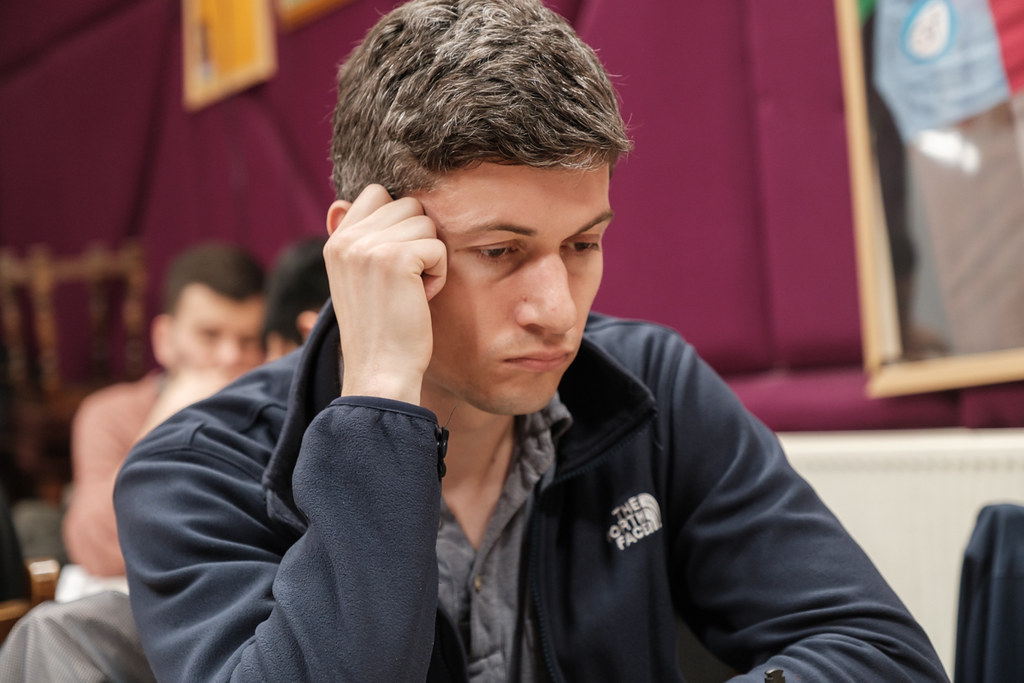
There was a result on the board – the whiteboard on the stage in the upstairs playing room at the Willoughby to be precise – almost straightaway. Will Taylor, with Black against Ian Heppell on board 7, agreed a draw in 10 moves in a book Petrov’s Defence position. Solidity personified from Will and a good result to begin, despite Will’s rating advantage. Ian is in any case almost certainly stronger than his rating suggests. This was the pleasingly bishop-heavy position in which peace was declared:
Rather less peaceful events were unfolding on board 4, where the wonderfully fluid and attacking Silverio Abasolo, with White, was giving Dan Rosen a very hard time. Dan boldly played a Pirc, but erred in this position:
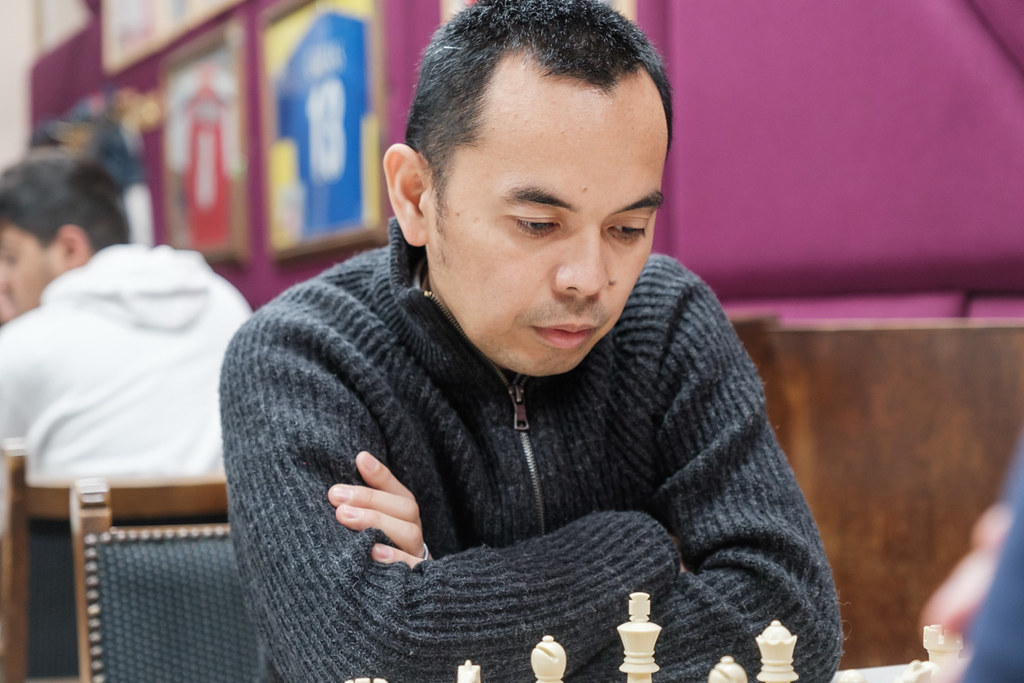
Silverio’s terrific early win put us 1.5-0.5 up, but it was followed by a couple of hours of slog. I was worried for Julian Way, playing a King’s Indian Defence against Sean Ingle on board 9, in the cramped position below after Sean’s 17. f4:
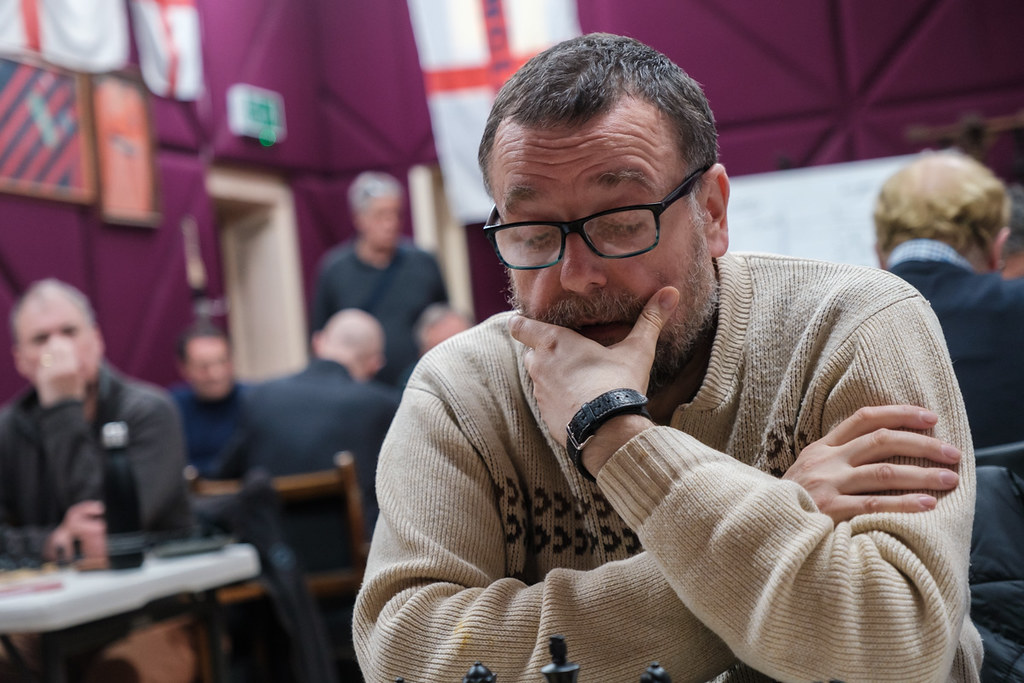
So far so good. That made it 2-1. Vladimir Li was playing Black on board 1 against Wimbledon’s Spanish IM, Alberto Suarez Real. Alberto opted for a Scotch and a characteristically intense and theory-heavy battle ensued. These two players have met each other on several occasions and clearly have great respect for each other. Black gained a tiny edge, but Alberto equalised and a draw was agreed on move 22 in the level position below:
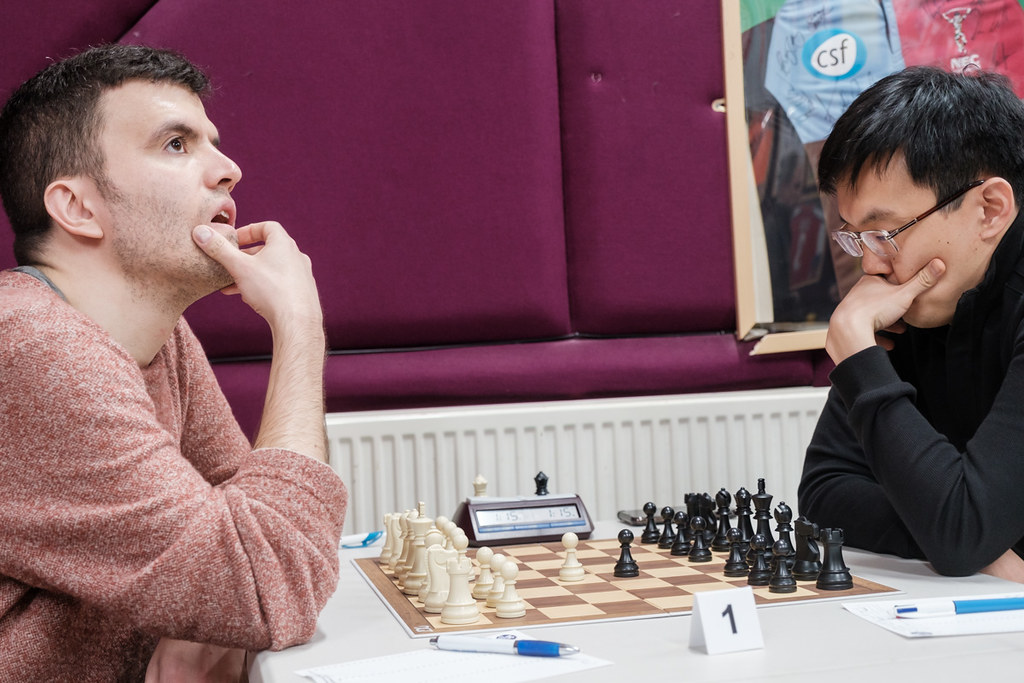
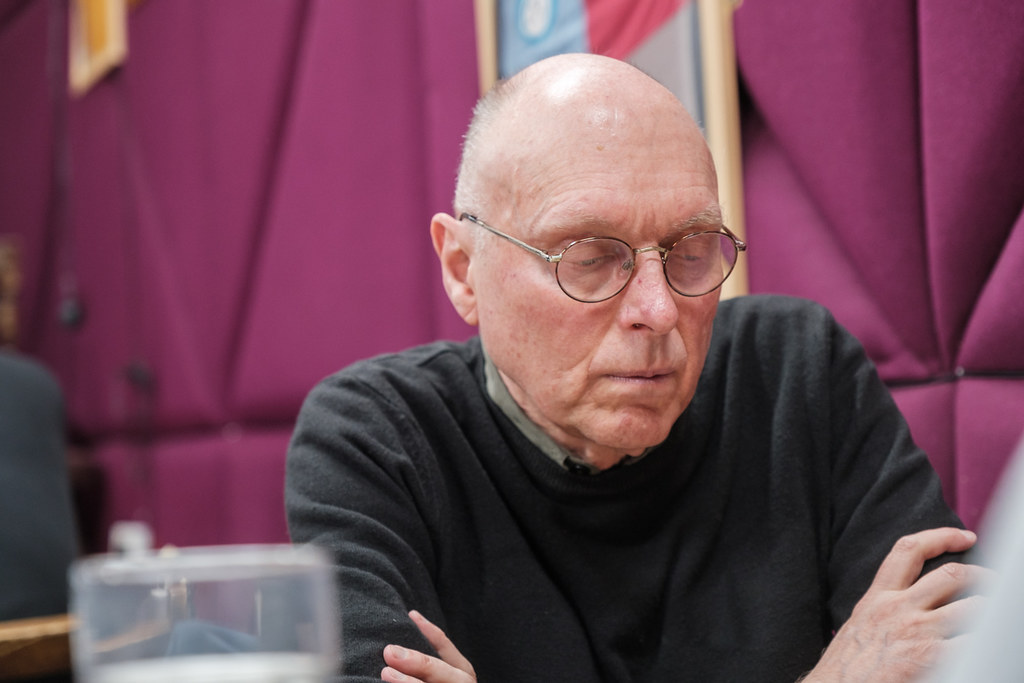
We were in a draw-dominated period of the match, with only Silverio’s quickfire win keeping us ahead. David Rowson gained a tiny edge against Girinath Haridas’s Modern Defence, but nothing significant and it was certainly legitimate to take a draw in the position below where David’s apparently superior coordination is largely illusory:
That made it 3-2 and not long after the score became 3.5-2.5 when Peter Andrews and Tony Hughes also agreed a draw. Peter and Tony know each other’s games well – so well that Peter, with White, departed from his usual opening repertoire and strayed into less familiar lines. This cost him time and he fell behind on the clock, as well as being slightly worse on the board in the final position he recorded (see diagram) before the five-minute rule kicked in:
But Peter is a doughty defender, didn’t panic and held the position with reasonable comfort. We were still only marginally ahead and the final result of the match was far from clear, but there wasn’t the same anxiety as in our previous two Alexander Cup finals – against Battersea last year and Wimbledon the year before. It felt as if we were playing like a professional unit. Perhaps we are getting better at handling these big matches.
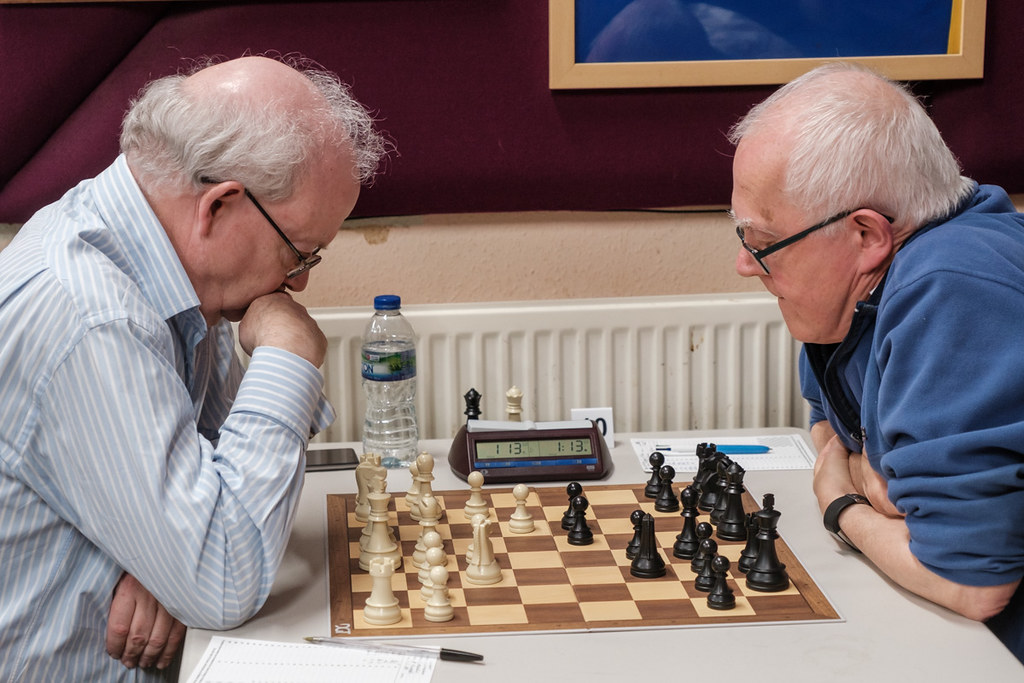
The Wimbledon fortress was in any case about to be breached. In the space of a few minutes Kingston’s two youngest players – David Maycock on board 2 and Luca Buanne on board 6 – secured the wins that took us beyond five game points and ensured that we would retain the Alexander Cup and complete the much-vaunted hat-trick of titles.
David’s board 2 opponent Russell Granat, a formidable attacking player, had been caught in traffic and arrived just after the half-hour default time. In the circumstances we did not enforce the default, wanting to win fair and square, a decision applauded by our opponents, in particular Russell Picot, who made a point of thanking me. But playing David Maycock is not easy at the best of times, and playing him with Black when you are 35 minutes down on the clock was too much for Russell. David, essaying a Ruy Lopez, did nothing spectacular (unusually for him); he just played immaculate, implacable chess. One over-ambitious pawn push in the position below sealed Russell’s fate:

Luca Buanne, with White on board 6, also played a powerful game against Neil Cannon’s Alekhine’s Defence, and was always ahead in the game despite Neil’s valiant attempts to get counterplay. After 35 moves Luca had reached this winning queen and pawn endgame, though it still had to be won, as indeed it was almost 20 moves later.
The wins by David and Luca came in quick succession and secured Kingston’s historic hat-trick of titles – greeted perhaps with relief rather than euphoria by the team’s supporters. That it was achieved by two young players who have only been representing the club since the end of the pandemic was especially satisfying. The Covid shutdown now feels like it facilitated a rebirth. Before then we bumbled along; since then we have been motoring. It could all end tomorrow – “O my MItcham and my Redhill long ago” – but for the moment we savour the success.

That left two games still in progress. Mike Healey, with Black on board 5 against the dangerous junior Shahvez Ali, eschewed his usual creative flights of fantasy, realising that a draw with Black was just what the doctor ordered. He offered a draw in the position below:
It is completely level, but White realised his team needed a win – we had not established an unassailable lead by this point – and persisted in trying to establish an advantage for a dozen more moves. Mike played with great precision, other games went against Wimbledon, and a draw was finally agreed.
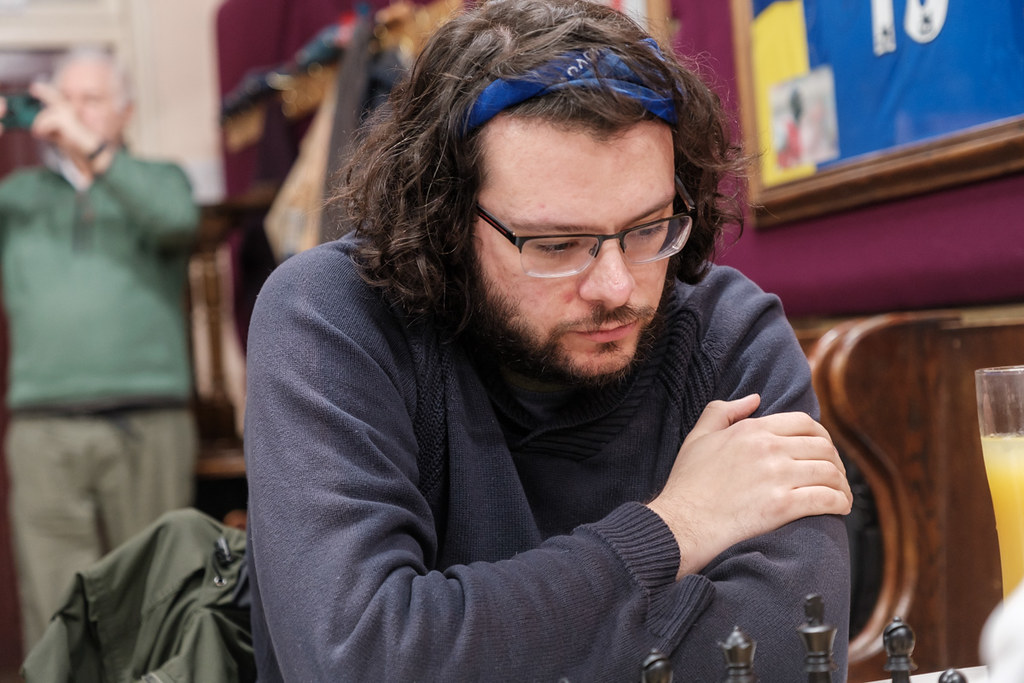
That, inevitably, left Peter Lalić still playing. Peter was under the weather and had spent much of the evening blowing his nose in the storage cupboard. Most players, if they felt unwell, would seek a quick exit, but Peter is sui generis and persisted in trying to win against the wonderfully urbane Russell Picot for more than three hours and precisely 142 moves. If this is Peter ill, imagine Peter well. Long games, for better or worse, are becoming his signature. The game went on late into the night and I was in the bar celebrating, so I must defer to my esteemed colleague Peter Andrews, who was by this point scoring the game in case a threefold repetition was claimed. Peter A takes up the story.
The last game to finish was on board 3. Peter [Lalić] described it as his “Immortal Game”. Anderssen-Kieseritzky (1851) was so named because the memory of the brilliant final combination was immortal. This time it was not the memory, although Russell Picot may carry the scars for some time, but the game itself which threatened to last for ever.

On the black side of a Botvinnik English, Peter achieved by move 20 the kind of blocked position in which he revels, and skilfully exploited White’s overextended queenside structure to launch a raid with his queen which won the a pawn on move 59 (see diagram below).
But he had to extricate his queen to ensure that it was not trapped, and with the position still blocked it seemed that a draw was inevitable – White offered a draw at least twice. However, the situation was ideal for Lalićian timebuilding – more or less indefinite woodshifting starting with both players on the increment, in which although there should be no breakthrough the under-pressure side has to exercise a little care, in this case to ensure that (1) the black a-pawn could not be pushed or (2) the black queen could not come to f4 without being opposed by the white queen. Not difficult in principle, but the combination of boredom and the requirement for care through an indefinite number of moves at 10 seconds a move may cause tiredness and a momentary loss of concentration.
That eventually occurred on White’s 120th move. Playing on 10-second increments, it may not have been clear what Black’s concentration on the c-file was intended to achieve, with no way to sacrifice the bishop for two pawns and a rook sacrifice being too high a tariff. However, Peter had used his accumulated time for a nice bit of visualisation in the position below:
Thus ends Peter Andrews’ superb analysis of his namesake’s game. I can hear every reader asking, “Why can’t Andrews do all the game analysis rather than the other bloke?” Because frankly he is far too expensive and has better things to do.
The Picot-Lalić epic ended at around 10.45pm. An odd coda in some ways – Peter L, coughing and spluttering but characteristically determined to win a game that had no material impact on the result of the match other than to ensure we won by the in the end comfortable margin of 7-3. In a rapidly emptying playing room, as holders we presented the Alexander Cup to ourselves, with president and non-playing Alexander Cup captain John Foley cradling it . Three years’ hard work was complete. What now? Should we weep for there are no more worlds to conquer? In Surrey anyway.
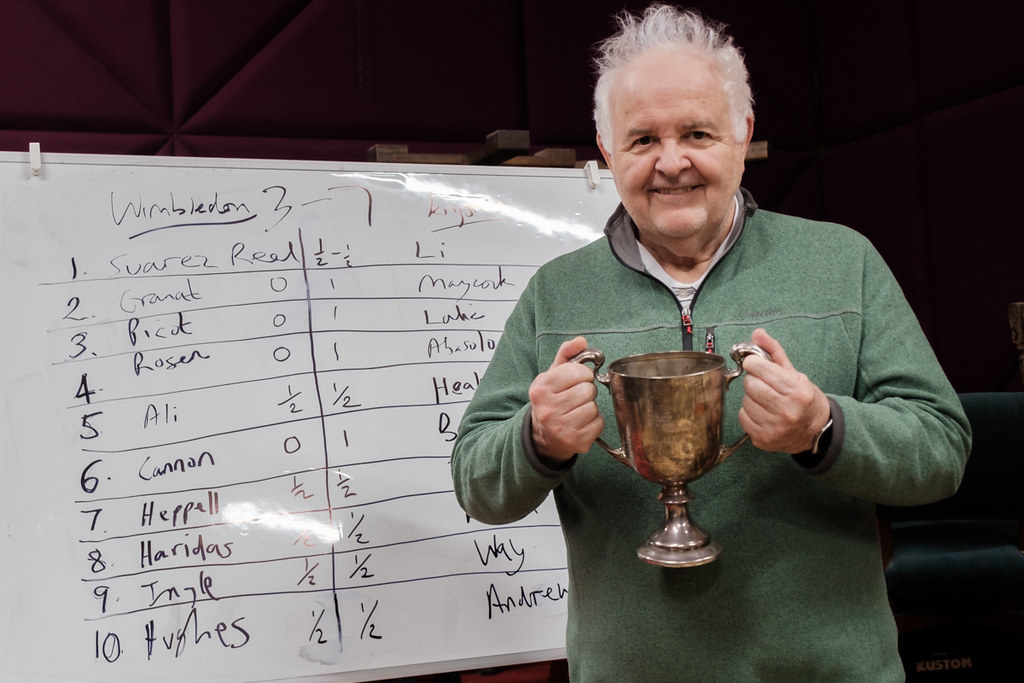
Stephen Moss, Secretary, Kingston Chess Club

This was also a league match!
Kingston’s Surrey League division 1 captain, Peter Andrews, writes:
The top eight boards of the Alexander Cup doubled as our postponed home league match against Wimbledon (a future quiz question might be: “How can a chess player be in two places at the same time?” Answer, a home league match and an away cup match are twinned.) Our 6-2 win over those boards meant that we finished with six match points out of eight, half a point (and also half a game point) behind Epsom.
It was naturally disappointing not to repeat last season’s championship and unbeaten record. The early defeats at Guildford, when we were missing some key players, and at home against Epsom, when our very strong side slightly underperformed, left us with too much ground to make up in the second half of the season, despite a fantastic team effort to pull off a win at Wimbledon when we were so depleted that some evoked the spirit of Agincourt. And we had a sense that as defending champions we had targets on our backs, and other clubs did their best to put out their strongest possible sides against us. So six points out of eight was a good effort, and it was particularly satisfying to beat Epsom fairly comfortably in the return match.
We drew on the resources of the whole club: 17 different players turned out at least once. Our mainstays were once again David Maycock (4.5/6) and Peter Lalić (4/7). Having two such consistent performers on high boards was crucial, and they were aided by the willingness of our other less regular leading lights, Vladimir Li, Silverio Abasolo and Mike Healey, to be flexible around board order so as to facilitate our preparation and frustrate our opponents’.
But we tended to have a greater rating edge slightly lower down, where David Rowson, liberated from the captaincy, scored 3.5/6, and John Foley 3/5. There were many other solid performances, and Luca Buanne [2.5/3] made an immensely promising debut late in the season. He will be a key component as we refresh the squad next season.
Final division 1 table

